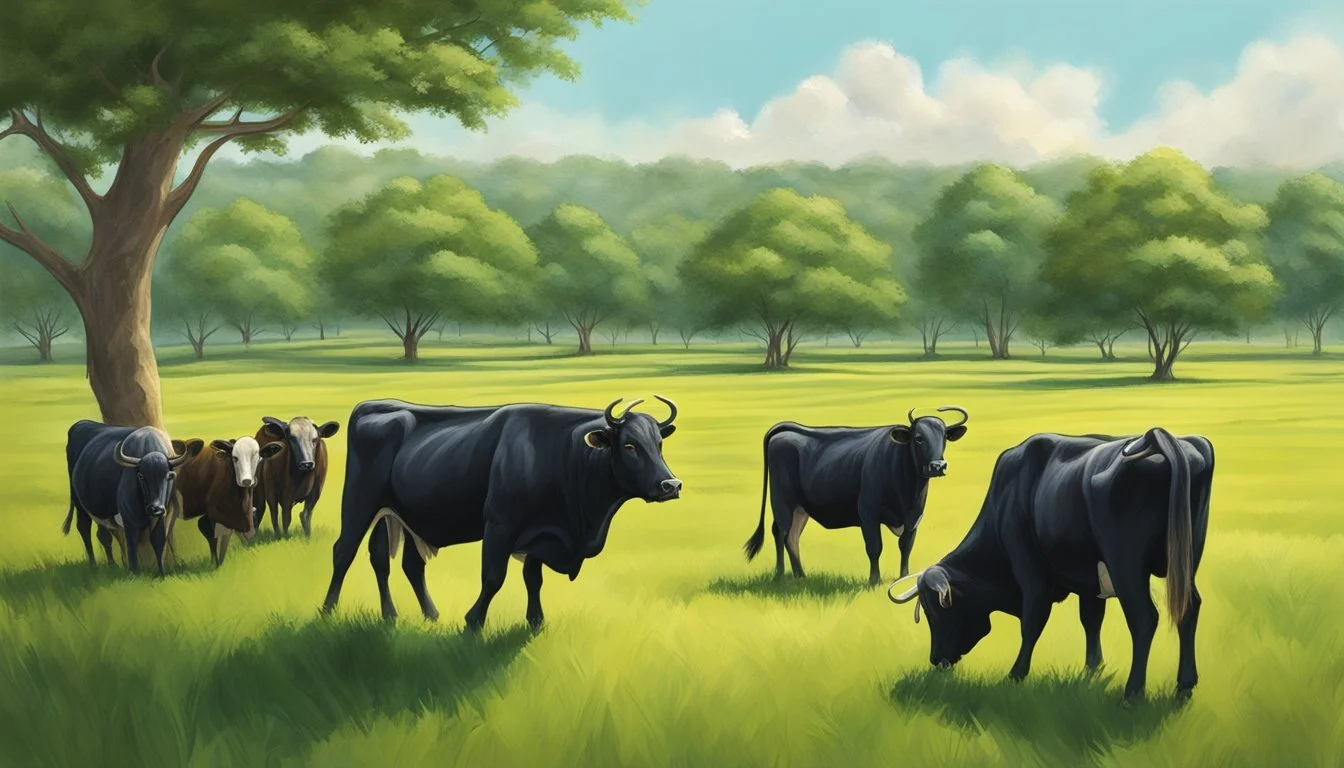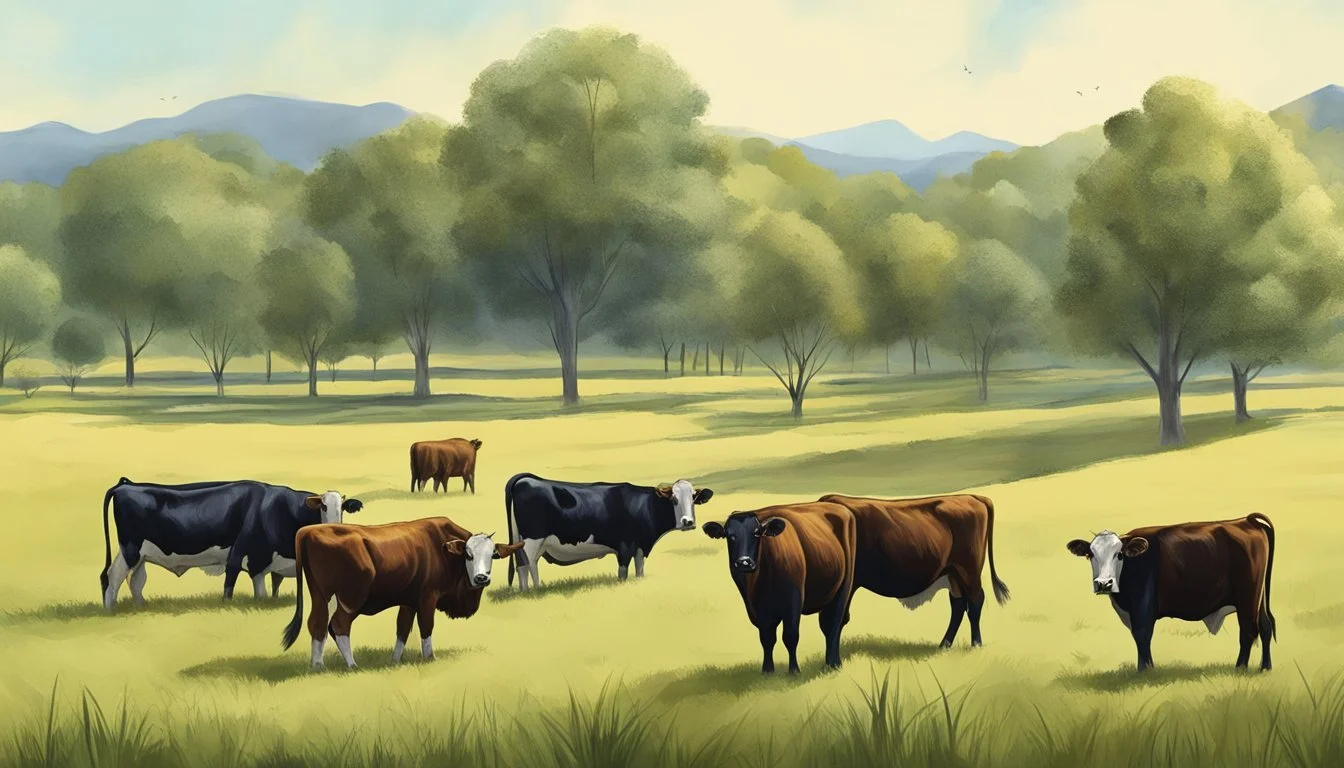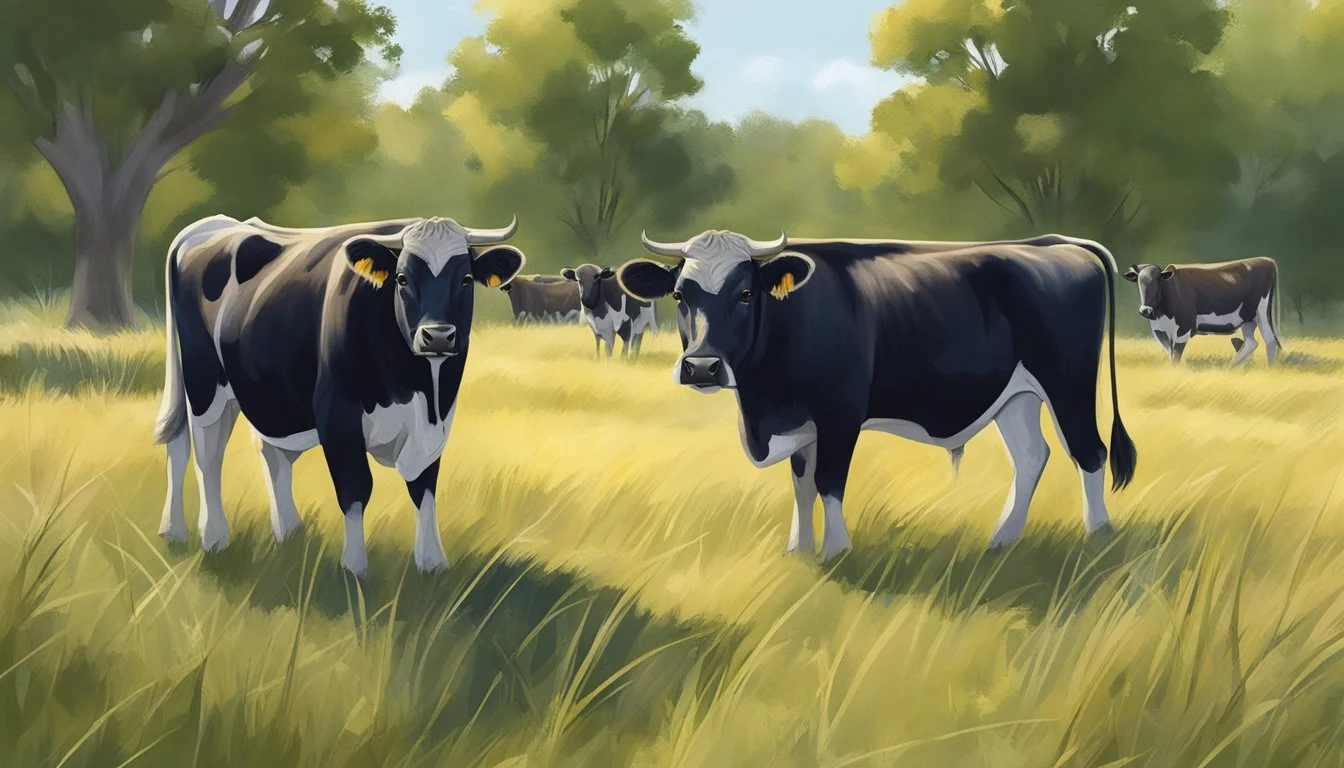Tackling Climate Change
Dexter Cattle's Role in Enhancing Carbon Sequestration
Tackling climate change remains one of the most urgent challenges of our time, as rising concentrations of greenhouse gases in the atmosphere contribute to global warming and the associated impacts on weather patterns, ecosystems, and sea levels. Among the multifaceted approaches to mitigate this crisis is carbon sequestration, which involves capturing atmospheric carbon dioxide (CO2) and storing it in a way that reduces presence in the atmosphere. One area of interest in this domain is the potential role of agricultural practices, particularly involving livestock like Dexter cattle, in enhancing carbon sequestration.
Dexter cattle, a small breed known for its hardiness and adaptability, are becoming increasingly recognized for their compatibility with regenerative grazing practices. Such practices aim to replicate the natural movements of wild herds, promoting the growth of diverse grassland ecosystems which can capture and store more carbon in soil. This method not only contributes to soil health but also bolsters biodiversity and water retention.
Exploring the interplay between Dexter cattle and carbon sequestration efforts is critical, as it exemplifies how targeted livestock management can contribute to climate change mitigation. Dexter cattle's suitability for small-scale and sustainable farming models offers a glimpse into how traditional cattle-raising techniques can be modified to meet contemporary environmental challenges while still supporting the agricultural economy.
The Role of Dexter Cattle in Agriculture
In addressing agriculture's impact on climate change, Dexter cattle emerge as a promising option due to their unique characteristics and their integration into sustainable beef production systems.
Livestock Production and Climate Change
The agricultural sector, specifically livestock production, contributes significantly to greenhouse gas emissions, with methane emissions from cattle representing a notable share. Methane, while shorter-lived than carbon dioxide, is vastly more potent in warming the atmosphere. Strategies to reduce methane emissions from livestock are therefore crucial in mitigating climate change.
Characteristics of Dexter Cattle
Dexter cattle are the smallest European cattle breed known for their hardiness and efficiency. They typically require less feed than larger breeds, translating into lower methane emissions per unit of meat produced. Their small stature also makes them suitable for grazing in conservation and rewilding areas, which can contribute to grassland preservation and carbon sequestration.
Size: Approximately one third the size of a Friesian cow.
Efficiency: Greater meat production per unit of feed compared to larger breeds.
Hardiness: Adaptability to various climates and conditions, beneficial for rewilding efforts.
Sustainable Beef Production with Dexter Cattle
When integrated into sustainable beef production systems, Dexter cattle can play a role in enhancing soil carbon sequestration. Practices such as rotational grazing can help maintain healthy grasslands, which are effective carbon sinks. These practices, alongside the natural advantages of Dexter cattle, support the pursuit of environmentally friendly animal husbandry and meat production.
Rotational Grazing: Helps maintain grassland health, increasing carbon storage.
Sustainable Practices: Dexter cattle require fewer inputs, which is key in reducing the overall environmental footprint of beef production.
Meat and Dairy: Despite being primarily raised for beef, Dexter cows also produce milk, adding versatility to small-scale sustainable farming operations.
Climate Impact and Carbon Footprint
Tackling climate change involves understanding the carbon footprint of agricultural practices, particularly in livestock farming. Dexter cattle are one focus of such studies due to their unique attributes and potential for sustainable farming.
Greenhouse Gases and Global Warming
Greenhouse gases, notably carbon dioxide, methane, and nitrous oxide, contribute significantly to global warming. Methane, though shorter-lived than carbon dioxide, has a global warming potential that is approximately 28-36 times higher over 100 years. Nitrous oxide, predominantly from soil management practices, is 265-298 times more potent than carbon dioxide on the same timescale. Livestock farming plays a notable role in emitting these gases, especially through enteric fermentation leading to methane production.
Carbon Footprint of Dexter Cattle
Dexter cattle, a smaller heritage breed, have been suggested to have a lower carbon footprint compared to larger breeds. Components of their footprint include:
Methane: Emissions from digestion.
Nitrous Oxide: Released from manure management.
Due to their efficiency in converting feed to body mass and generally requiring less feed, Dexter cattle could represent a stride towards sustainability. However, comprehensive data on their specific methane emission rates and overall carbon footprint is limited.
Comparative Analysis with Other Cattle Breeds
Comparing Dexter cattle with other breeds highlights their potential benefits in carbon sequestration efforts:
Breed: Dexter
Feed Efficiency: High
Methane Emissions: Lower*
Manure Volume: Lower
Larger Breeds
Feed Efficiency: Lower
Methane Emissions: Higher
Manure Volume: Higher
*Assumption based on smaller size and reduced feed intake.
It is proposed that through regenerative practices, such as improved grazing that mimics natural ecosystems, Dexter cattle could enhance soil carbon storage, further offsetting their overall greenhouse gas emissions.
Grazing Practices and Land Management
Effective grazing practices and land management strategies are pivotal in harnessing the potential of Dexter cattle for carbon sequestration efforts. These cattle, when managed correctly, play a crucial role in the promotion of soil health and conservation through their grazing patterns.
Effect of Grazing on Carbon Sequestration
Grazing, when managed strategically, can have a significant positive impact on carbon sequestration. Dexter cattle, known for their smaller size and lighter weight, cause less soil compaction than larger breeds, thereby preserving soil structure and promoting aeration. This facilitates an environment where microorganisms can thrive, increasing soil organic matter and enhancing the capacity of soils to store carbon. Practices such as rotational grazing are vital to optimizing grazing patterns for maximum carbon uptake.
Grazing Land and Grassland Management
Grassland and grazing land management are intrinsically linked to the effectiveness of Dexter cattle in carbon sequestration efforts. Managed grazing through techniques like silvopasture, the integration of trees, forage, and grazing in a single system, can enhance the biodiversity of the ecosystem. Moreover, keeping grasslands intact and preventing their conversion to agriculture or urban land use is fundamental in maintaining their role as carbon sinks.
Key Factors in Effective Management:
Sustaining diverse plant communities
Maintaining grazing intensity at sustainable levels
Employing periodic rest periods for pasture regrowth
Regenerative Agriculture and Soil Health
Regenerative agriculture practices, which aim to rehabilitate and enhance the entire ecosystem of the farm, are crucial in the improvement of soil health and overall productivity. Dexter cattle contribute to this by:
Stimulating plant growth through selective grazing
Recycling nutrients via manure, which enhances soil fertility
Promoting water infiltration in soils, bolstering resistance to drought
The synergetic relationship between regenerative agriculture and grazing practices leads to a resilient agricultural system that supports both robust cattle health and vibrant soil ecosystems capable of long-term carbon storage.
Carbon Sequestration Science
Carbon sequestration is a critical process in the fight against climate change, involving the capture and long-term storage of atmospheric carbon dioxide. This section provides an overview of the scientific underpinnings of this process, focusing on soil carbon sequestration, the role of plants in capturing carbon, and the latest research on soil organic carbon.
Soil Carbon Sequestration Processes
Soil carbon sequestration occurs when CO2 is absorbed from the atmosphere and stored in the soil as organic carbon. This process can be enhanced through practices that increase soil organic matter, such as the application of compost or planting cover crops. Researchers emphasize the importance of understanding the complex interactions within the soil that lead to carbon sequestration, which includes the decomposition of organic matter and the stabilization of carbon by soil minerals.
Role of Plants and Photosynthesis
Plants play a pivotal role in carbon sequestration through photosynthesis, by which they convert CO2 into organic compounds that can either be stored in plant tissues or transferred to the soil. Grasslands and perennial plants, such as those found in managed pastures with Dexter cattle, are particularly effective because they have extensive root systems that contribute to soil carbon stocks. It is the balance of carbon capture by photosynthesis and carbon release through respiration and decay that determines the net amount of carbon sequestered.
Research on Soil Organic Carbon
Ongoing research is key to enhancing soil carbon sequestration. Studies employ various models, such as the Rothamsted Carbon Model, to simulate and predict changes in soil organic carbon under different land management scenarios. These include regenerative agricultural practices, which aim to improve soil health and increase its carbon content. Researchers analyze data across different regions and contribute significantly to the understanding of how sustainable practices can optimize the role of agriculture in carbon sequestration.
Environmental and Ecosystem Benefits
The integration of Dexter cattle into farming practices offers multifaceted environmental benefits, enhancing biodiversity and promoting soil health.
Biodiversity in Pastoral Ecosystems
Dexter cattle, by their grazing habits, can maintain diverse pastoral ecosystems. Their presence supports varied plant species, which in turn attract and sustain a range of wildlife and insects. Controlled grazing practices ensure that the cattle contribute to maintaining a balance in the ecosystem, rather than causing overgrazing which can lead to a decline in plant species.
Reduction of Soil Erosion
Through their grazing, Dexter cattle play a role in reducing soil erosion. Their movement across the land helps to naturally aerate the soil, which is crucial for water retention and preventing run-off. This effect is maximized when grazing is managed to avoid compaction and overuse of a particular area.
Manure as a Natural Fertilizer
The manure of Dexter cattle acts as a natural fertilizer, rich in nutrients and beneficial microorganisms. It enhances soil fertility and structure, thereby increasing the soil's capacity to act as a carbon sink. The nutrient-rich manure reduces the need for synthetic fertilizers, which are associated with high GHG emissions during their production and application.
These practices contribute not only to conservation efforts but also to mitigating climate change by enhancing the land's ability to capture and store carbon, all the while lowering overall greenhouse gas emissions.
Policy and Economic Considerations
This section explores the role of Dexter cattle in the context of climate change policies, their economic sustainability, and the incentives for adopting greener farming practices.
Climate Policies and Livestock Sector
Current climate policies aim to reduce GHG emissions, and these often affect the livestock sector due to its considerable impact on greenhouse gas outputs. The Food and Agriculture Organization (FAO) underscores the need for sustainable livestock farming methods. Policymakers at various levels are looking into ways to balance economic growth with environmental sustainability, which includes regulating practices contributing to land use change and incentivizing carbon sequestration.
Economic Viability of Dexter Cattle Farming
Dexter cattle, a smaller breed of cattle, offer potential economic advantages for ranchers. Their size allows for more efficient land use and potentially lower feed costs. The breed's hardiness also translates to potentially reduced veterinary expenses. Studies suggest these advantages may contribute to a more sustainable economic model for farmers when integrated with climate-smart farming practices.
Incentives for Sustainable Practices
Incentives play a crucial role in encouraging ranchers to adopt practices that align with carbon market opportunities. This includes:
Tax credits: For verified carbon sequestration efforts.
Subsidies: Directed at sustainable livestock management.
Grants: For research into and implementation of best practices.
Through these financial mechanisms, the goals of reducing GHG emissions and promoting sustainable agriculture may be economically viable for ranchers.
Global Perspective on Dexter Cattle
Dexter cattle, as the smallest European breed, are increasingly significant in sustainable agriculture due to their hardiness and lower environmental footprint. They are gaining attention for their potential in carbon sequestration efforts worldwide.
Role in North American Agriculture
In North America, particularly the United States and Canada, Dexter cattle are valued for their dual-purpose nature—providing both meat and milk. Their small size means they require less pasture and food, making them an efficient option for small-scale farmers focused on environmentally sustainable practices. They contribute to the diversification and resilience of the regional livestock sector.
Adaptation to Different Climates
Dexter cattle are exceptionally adaptable to various climates, thriving from temperate regions of North America to wetter and cooler climates. This capability positions them well to cope with climate variability and the emerging challenges of global warming. Their versatility enables their use in diverse environmental conservation and rewilding projects aimed at maintaining ecological balance.
Impact in Developing Regions
In developing regions, such as sub-Saharan Africa and South Asia, Dexter cattle's low maintenance and adaptation to diverse environments make them suitable for smallholder farms. Their presence can sustain livestock production systems while potentially reducing the climate impact, which is crucial given the rising concerns about food security and environmental sustainability in these areas.
Dexter cattle hold promise in contributing to the global efforts in climate change mitigation, offering a sustainable alternative within the cattle industry.
Conclusion
Dexter cattle play a role in the broader framework of climate action and sustainable development. As small-sized, hardy livestock, they present an opportunity for incorporation into mitigation strategies aimed at reducing greenhouse gas emissions. Their potential to thrive on less intensive grazing systems makes them suitable candidates for practices that promote soil health and carbon sequestration.
Adopting regenerative agricultural techniques, such as high-frequency rotational grazing, can enhance soil carbon storage. The activity of Dexter cattle in such systems can assist in reducing soil compaction, supporting increased water infiltration and microorganism diversity, both vital for long-term carbon storage.
Investment in research is paramount to quantify and validate the impact of Dexter cattle within different ecosystems. Stakeholders can then make informed decisions about herd management aligned with climate goals.
It is crucial to balance livestock production with environmental stewardship. Dexter cattle offer a compelling case for integration into sustainable farm systems, demonstrating that livestock management and climate mitigation can coexist with the right strategies.
As with all approaches to climate mitigation, the adoption of Dexter cattle into carbon sequestration efforts should be viewed as one piece of the multifaceted puzzle of climate action. Collaboration across sectors and disciplines will ensure the most effective and sustainable outcomes for both agriculture and the environment.






